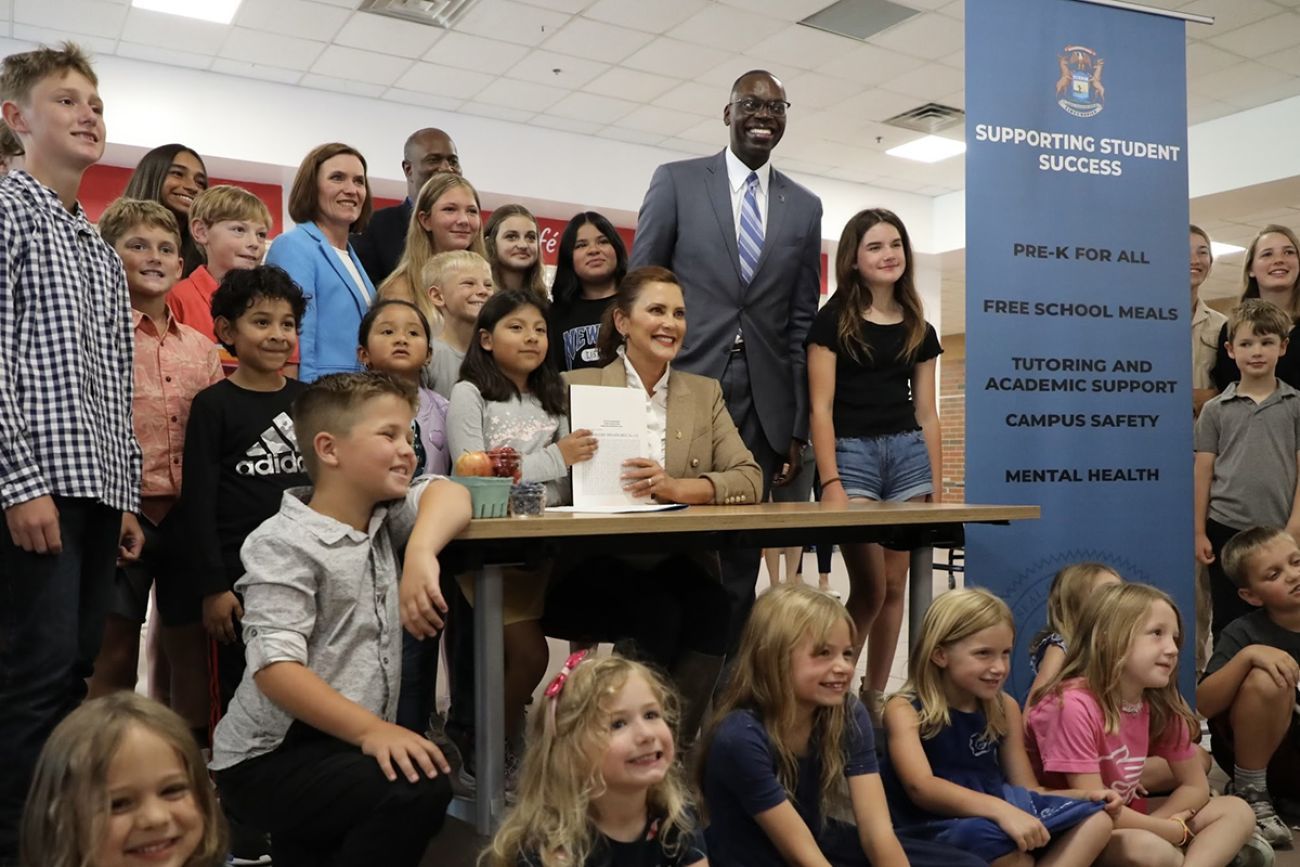Michigan school tutoring funds not likely until spring state officials say

- The $150 million Mi Kids Back on Track program will pay districts to implement high-quality tutoring programs
- Districts will need to submit detailed plans to the state to qualify for funding
- Some districts plan to offer tutoring in the fall before the state funds are available
Michigan Gov. Gretchen Whitmer signed off in July on a record public education budget that included $150 million for individualized tutoring and academic support to help the state’s struggling students recover from pandemic learning loss.
But a state education official told Bridge Michigan it could take until the spring semester for formalized tutoring programs to be ready for students across the state.
That means school districts must continue to rely for much of the new school year on a patchwork approach to finding teachers or other instructors to help students who are behind in core areas like reading or math.
Related:
- What to know about Michigan’s universal free school meals program
- Whitmer signs ‘transformative’ $24.3B Michigan education budget. What to know
- The future of student loan forgiveness: What to know in Michigan
And there are a lot of them. Michigan students score toward the bottom of states on the National Assessment of Educational Progress (NAEP), often called the nation’s report card. Michigan fourth graders’ average scale score ranked 40th in the nation in reading and 35th in math. The state’s eighth graders ranked 23rd in reading and 25th in math.
Lou Steigerwald, superintendent at Norway-Vulcan Area Schools in the Upper Peninsula, said his district will have tutoring for middle school students a couple times a week likely starting in mid-September.
The district will likely apply for Whitmer administration Mi Kids Back on Track funds. But he said small, rural districts do not have the same access to big tutoring companies as districts in metropolitan areas. Instead, he said, he’s reliant on his staff members being willing to work after school.
Westwood Community Schools near Detroit said it intends to have tutoring for elementary students from Beyond Basics, a Southfield-based nonprofit, this fall. Superintendent Stiles Simmons said he anticipates the district will apply for Mi Kids Back on Track funding as well.
“We can’t afford to wait,” he said, “but we certainly will take advantage of any funds that are intended to help improve literacy outcomes for our students.”
Years after the pandemic first disrupted Michigan K-12 classrooms, Michigan lawmakers and the governor signed off last month on an education budget that includes $150 million for individualized tutoring or academic support to address “unfinished learning.”
But tutoring funds come with strict requirements that will take time to implement.
Public school districts must agree to use “evidence-based” practices and ensure tutoring programs include training and coaching. Districts will also need to collect and share data about student demographics, tutoring frequency and outcomes from the tutoring.
Ruth Anne Hodges, manager of education experiences in the Office of Educational Supports at the Michigan Department of Education, told Bridge there is a two-part process to apply for tutoring funding. If things go according to plan, Hodges estimates districts will receive state tutoring funds at the end of February or early March, if not before.
The state will calculate funding for eligible districts based on the number of students not proficient in math or reading. Districts then must submit plans for how they intend to spend the money.
State assessment scores for the 2022-2023 school year have not yet been publicly released, but roughly a third of Michigan third-graders in the 2021-2022 school year were not proficient in English language arts.
Many Michigan school districts relied on federal relief funds to pay for tutoring programs during the pandemic. But reporters from Bridge Michigan, Chalkbeat Detroit and the Detroit Free Press found that many of the programs adopted by districts during the 2021-2022 school year varied in scope and in their adherence to best practices in effective tutoring.
Reporters analyzed over 800 district spending plans submitted to the state and surveyed, interviewed or visited 16 school districts and found that student-tutor ratios were often higher than were recommended and districts often relied on their own teachers to take on the additional task of being tutors after school. This often limited the effectiveness of the programs as districts coped with staffing shortages and teacher exhaustion.
Hodges, of MDE, said the state will have to monitor if districts eligible for the program select evidence-based practices.
Different states have taken different approaches to encouraging and, at times, requiring tutoring. Texas lawmakers passed a law that requires students who fail the state assessment to be assigned an effective classroom teacher or receive tutoring. Tennessee has offered school districts matching grants to provide tutoring services.
“Michigan, by having their policy come out now, is certainly behind several states but ahead of probably at least half of the states, I’m sure,” said Kathy Bendheim, managing director at the National Student Support Accelerator (NSSA), a group out of Stanford University that shares tutoring research and helps create evidence-based programs.
She said Michigan’s program incorporates “high-quality standards” in its policy but must ensure tutoring programs are actually implemented as designed.
“The urgency of the situation makes you want to do it for all kids immediately,” she said. “But what we have learned is that starting small — smaller — getting it right and building those real champions makes the expansion so much easier.”
Kimberly Dadisman, of the Abdul Latif Jameel Poverty Action Lab, a global research center that supports evidence-based policy to help reduce poverty, said there needs to be rigorous research on the effectiveness of tutoring programs. That’s especially important, she said, if school leaders want state and federal leaders to fund these types of programs moving forward.
“There hasn't been a lot of rigorous studies around how to scale up tutoring,” said Dadisman, the North America lab’s associate policy director.
She said the pandemic, which caused massive disruption and learning loss, also spurred some tutoring innovations, including a model where students spend part of their time with an in-person tutor and then practice their skills with computer-assisted learning.
Dadisman anticipates a lot more research on tutoring coming out in the next six to 12 months.
The Stanford NSSA program noted some of the difficulties school districts had implementing high-impact tutoring.
Schools reported having trouble finding enough tutors, scheduling tutoring during the school day, ensuring good student attendance and getting buy-in from school staff. Researchers also identified challenges around programs having access to high-quality instructional materials and program data collection.
NSSA also outlined potential solutions, including having schools partner with a local college or university to get college students who are studying to become teachers to work as tutors in local schools.
“Our firm belief is that every educator and district leader wants to do the right thing, but who has time to read these dense research papers and distill from them the two things that you should do tomorrow that would make better outcomes for kids?,” said Bendheim, the NSSA managing director.
The Michigan tutoring program could help provide that information.
The Mi Kids Back on Track program allocates $600,000 for the Clinton County Regional Educational Service Agency to work with the Michigan Association of Intermediate School Administrators (MAISA) to help local districts select “high impact tutoring strategies,” maintain a list of tutoring vendors that align with the law’s requirements and provide an annual report of tutoring programs to state leaders.
Lisa Lockman, director of operations and grant management at MAISA said the group is “reviewing over a dozen existing programs currently housed” in its clearinghouse to make sure it meets the law’s criteria.
Michigan Education Watch
Michigan Education Watch is made possible by generous financial support from:
Subscribe to Michigan Education Watch
See what new members are saying about why they donated to Bridge Michigan:
- “In order for this information to be accurate and unbiased it must be underwritten by its readers, not by special interests.” - Larry S.
- “Not many other media sources report on the topics Bridge does.” - Susan B.
- “Your journalism is outstanding and rare these days.” - Mark S.
If you want to ensure the future of nonpartisan, nonprofit Michigan journalism, please become a member today. You, too, will be asked why you donated and maybe we'll feature your quote next time!






